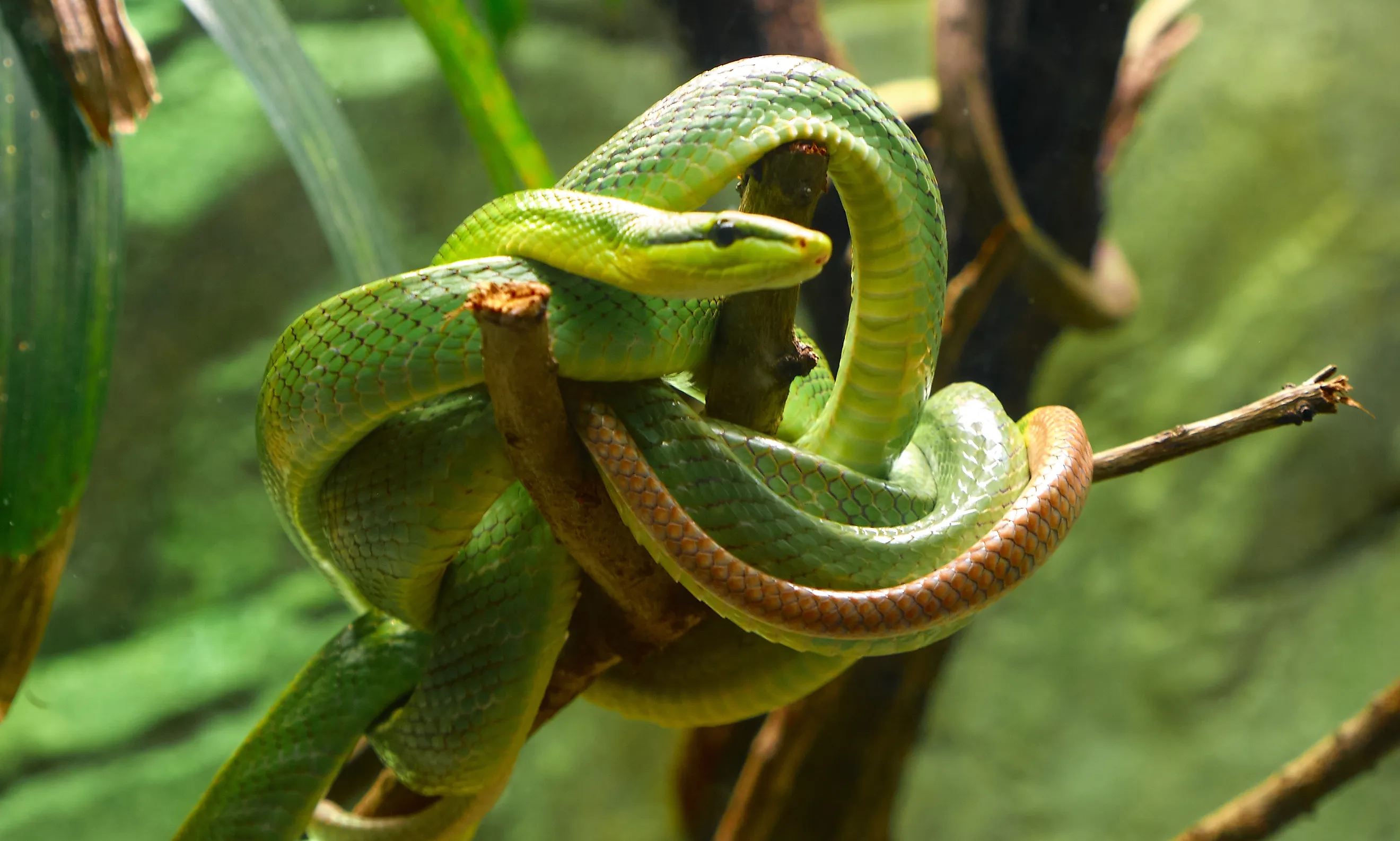
9 Green Snake Species Slithering Around The World
The term 'green snake' can refer to globe-slithering serpents that have this color explicitly stated in their names, or it can, of course, include any snakes that exude the verdant skin tone. Either way, there are a host of brilliantly adorned limbless reptiles that span several continents—from the slick Asian vine snake, to the highly-venomous mambas of sub-Saharan Africa, to the mesmerizing and scale-shattering constrictors of the Amazon. Let's hone in on both the formally-designated and visually-relevant groups in order to cover the most striking green snakes this world has to offer.
Green Snakes By Name
Rough Green Snake
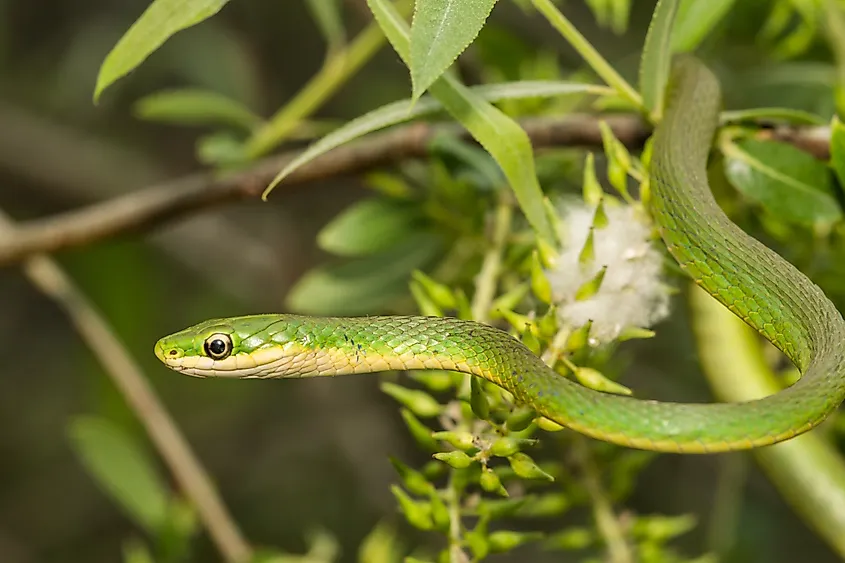
Rough Green Snake.
The nomenclature for our first two serpents don't leave much to the imagination. The rough green snake (Opheodrys aestivus), sometimes written greensnake, for instance, is both green (a rather bright green, in this case, with more of a creamy-yellow belly), and covered in rough-looking scales. This slender, non-venomous, and semi-arboreal fellow grows to around 3 feet long and can be found throughout much of the southeastern United States—from southern New Jersey down to the Florida Keys—hanging around the edges of forests, near ponds or lakes.
Rough green snakes take to the ground by day (where they hunt for insects, spiders, snails, and frogs) and retreat to the trees by night. Southern populations are active the entire year, whereas the northern (relatively speaking) compatriots hibernate during the winter. Other than for reproduction purposes, rough green snakes are solitary.
Smooth Green Snake
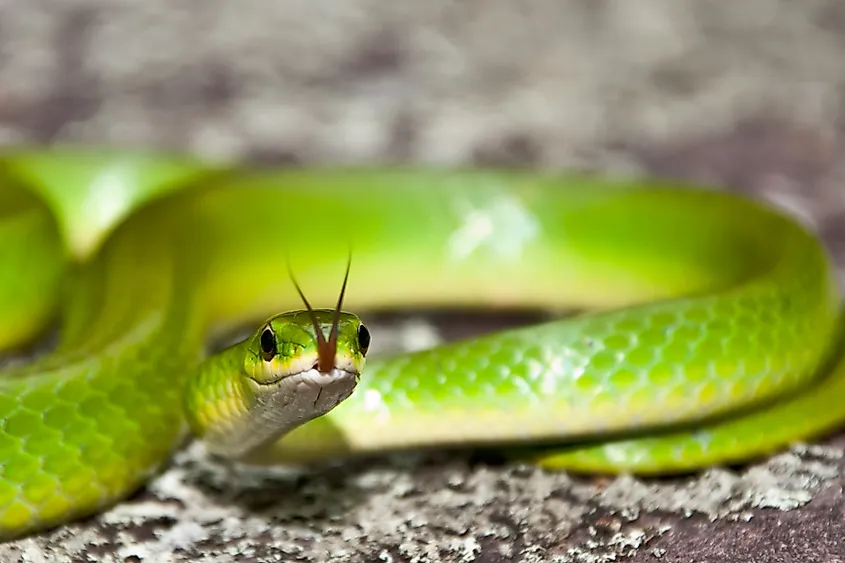
Smooth Green Snake.
Like its rough cousin, the smooth green snake (Opheodrys vernalis) is slim, bright green with a yellowish belly, predominantly insectivorous, and completely harmless to humans. But this time, its scales have a smooth appearance (how about that?). With that said, the difference between the two species is more than superficial.
The smooth green snake occupies more northerly latitudes. Stable populations occur from eastern Canada (including the northeast) west to Saskatchewan, and south through the Great Lakes region into Virginia. Isolated populations can also be found in pockets throughout the central and south-central United States. The smooth green snake, which is about 1 to 2 feet long, also prefers to keep to the ground. Its pigmentation helps it to blend in with prairie grasses, wetlands, and other areas of dense vegetation.
Green Anaconda
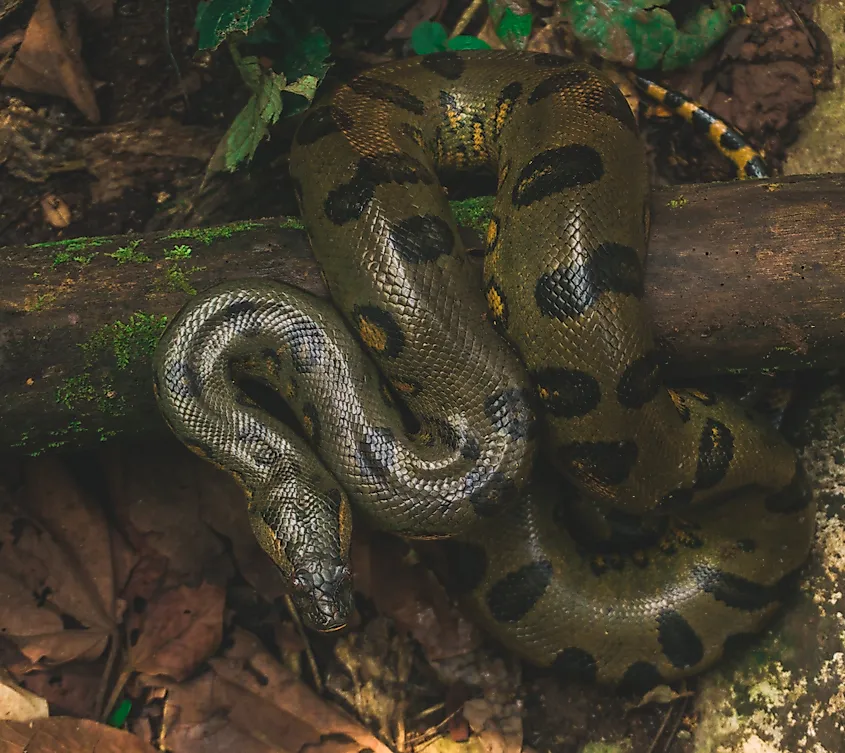
The Anaconda is one of the largest snakes in the boa family. An Ariel, birds eye view of an anaconda in the jungle.
The green anaconda is, by-far, the heaviest, and also one of the longest snakes in the world, growing up to lengths more than 29 feet and weighing in at over 550 pounds. So it's fair to call this infamous member of the boa family the largest living snake (check out the lengendary Titanoboa for the biggest of all time). But it's not just the green anaconda's girth that makes it so compelling. Due to its habitat in remote areas of the Amazon and Orinoco basins, its tendency to stay nearly submerged in marshes, swamps, and slow-moving waters, and its elusive nature, scientists are continually discovering more about this enormous snake.
Green Tree Python
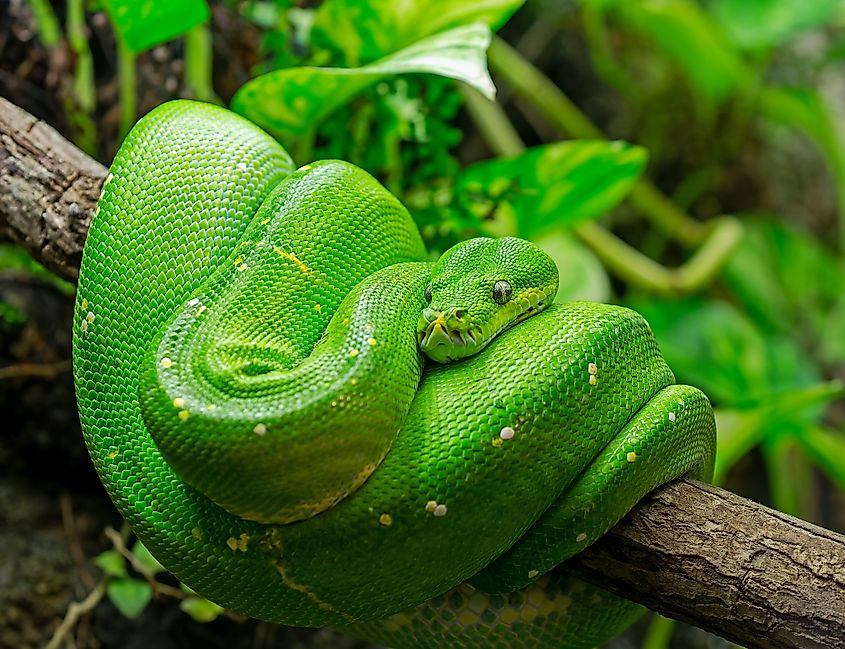
Close-up view of a green tree python (Morelia viridis).
Found in New Guinea, eastern Indonesia, and the northeastern portion of Australia's Cape York, the green tree python (Morelia viridis) is an impressive entity. Adults grow up to 5 feet in length, possess a rich green coloration (with bright yellow, white, and sometimes even blue spots), and have a diamond shaped head that's capped off with bulging black eyes. These mature features, combined with a prehensile tail, facilitates (as the name suggests) an arboreal lifestyle.
Green tree pythons can blend in amongst the canopy, but they also snatch unsuspecting prey (i.e. small mammals and other reptiles) after luring them with a dangling tail (talk about death from above). Juveniles, on the other hand, may be yellow or red-hued. This helps them to blend in with the forest floor, and/or edge of the rainforest, while they build their climbing skills.
Green Mamba
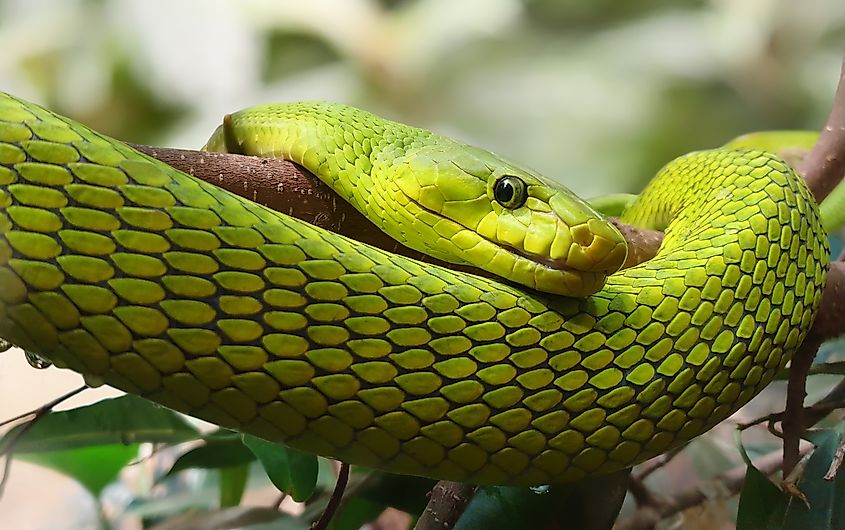
Close-up view of an Eastern Green Mamba (Dendroaspis angusticeps).
While all snakes deserve a wide berth, the green mamba is the first snake on our list that is highly-venomous. The eastern green mamba (Dendroaspis angusticeps) inhabits the forests of sub-Saharan Africa's east coast, whereas the western green mamba (Dendroaspis viridis) resides along the coast of northwest Africa. The former is brightly-colored, whereas the latter is a dull-green, or even light-blue snake, overlaid with black and yellow. They range from about 5 to 7 feet.
Both are shy and arboreal, and therefore, generally evasive, but they are extremely agile and aggressive when they need to be. If threatened, green mambas may strike repeatedly, injecting a potent neurotoxin that can be deadly to humans if the appropriate antivenom isn't promptly administered. Unfortunately, because eastern green mambas resemble multiple non-venomous snakes (such as the African green water snake, boomslang, and the spotted bush snake mentioned below), slender, bright green snakes of all sorts are needlessly killed in Southern Africa.
Emerald Tree Boa
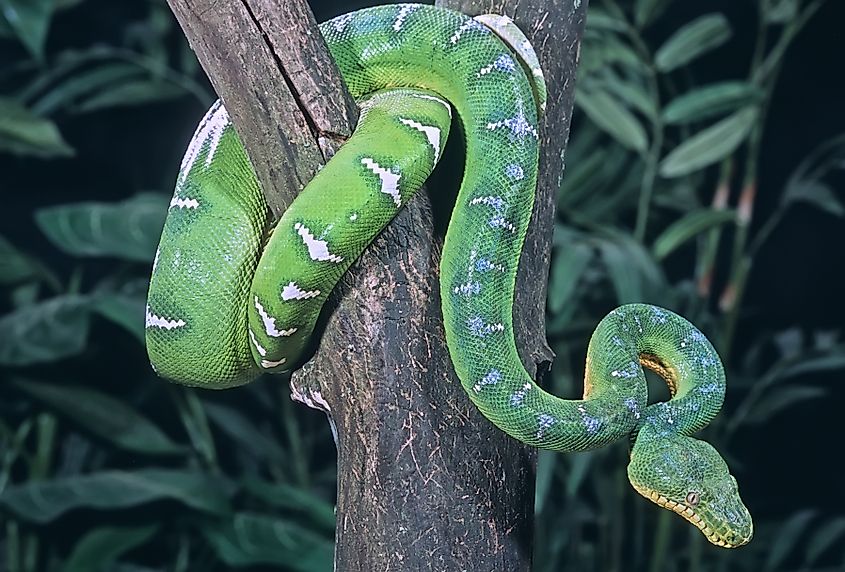
Emerald tree boa coiled in tree.
Though less explicitly stated, the Emerald tree boa (Corallus caninus) is a worthy mention. And while it is similar in appearance and behavior to the aforementioned green tree python, this South American beauty is quite literally a world away (and therefore a marvellous example of parallel evolution).
The dorsal scales of the emerald tree boa are actually brighter green than the gemstone after which it's named—once again drawing inevitable comparisons to the arboreal constrictor of Oceania. And like the green tree python, juvenile emerald tree boas start off with a much different coloration (in this case, red or orange). What makes this Amazonian snake distinct is its large head, doglike snout, catlike pupils, and white overlays that resemble lightning bolts or diamonds. They can reach up to 6 feet in length or more.
Other Notable Green-Colored Snakes
African Bush Viper
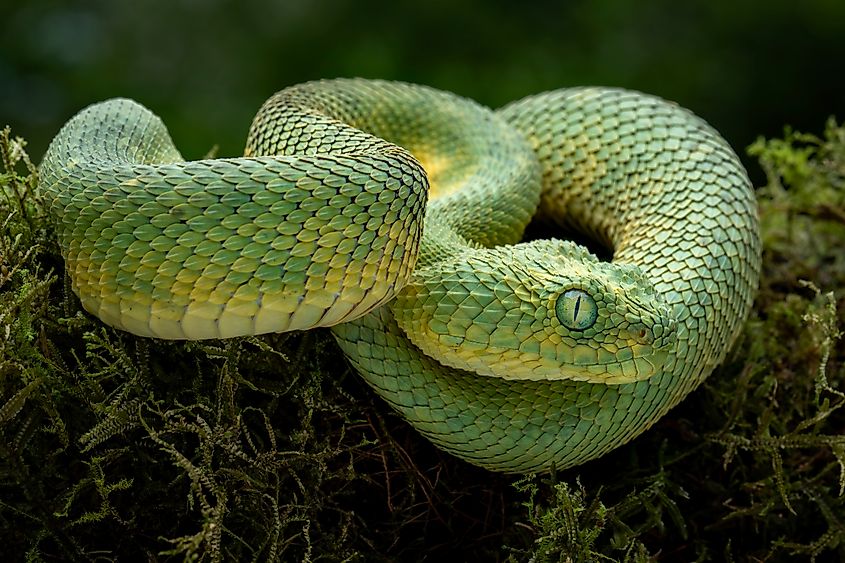
West African Bush Viper are a gorgeous viper from Western Africa.
The African bush viper (Atheris squamigera) is vibrant, venomous (with no available antivenom), and viviparous. And though commonly called the "green viper," this ambush predator of the rainforests of West and Central Africa comes in as many colors as the rainbow (it can even change throughout its lifespan).
Along with its ostentatious hues, the 30-inch long African bush viper sports dynamic, spiky scales, a blunt, almost angry-looking snout (pardon the projection), and vertical pupils within prominent, cosmic eyes. Unlike some of the heavier tree-dwellers previously cited, this brave and agile snake is most commonly seen between 100 to 400 meters (328 to 1,312 feet) above the tropical canopy. Therefore, birds make up a solid portion of a diet that is rounded out with rodents, amphibians, and small reptiles.
Spotted Bush Snake
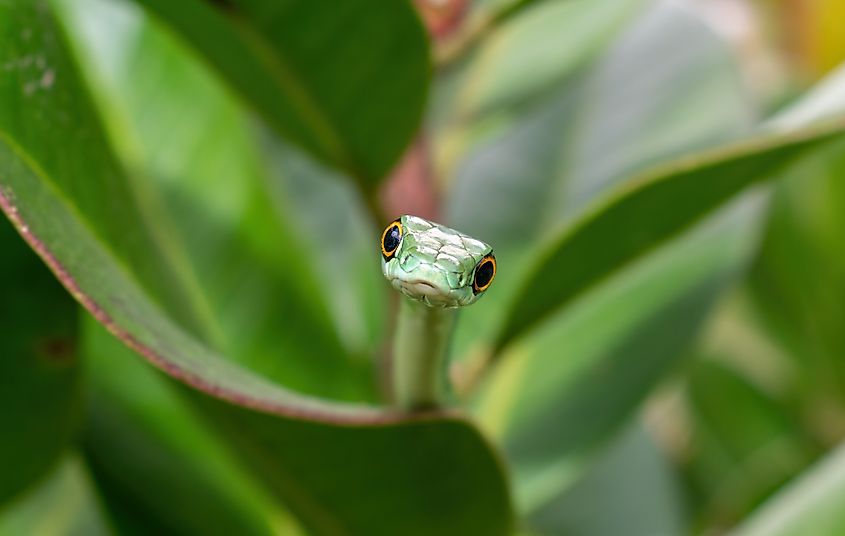
Cute Spotted bush snake (Philothamnus semivariegatus).
Another visually arresting (though this time harmless) African tree dweller is the spotted bush snake (Philothamnus semivariegatus). This slender, sinewy creature reaches 2 to 4 feet and occupies large swaths of the continent's central and southern portions. It can move seamlessly through the trees, but has also adapted to the walls and rafters of modern society.
Though sometimes mistaken for venomous lookalikes, the spotted bush snake can be distinguished by the dark overlays (for which it gets its common name) on the first third to half of its body, its tapered, off-color tail (sometimes copper-brown), and its bright orange eyes. This snake loves to eat geckos and other small lizards, but will also turn its attention to birds, frogs, and even the odd bat, should the need and opportunity present itself.
Asian Vine Snake
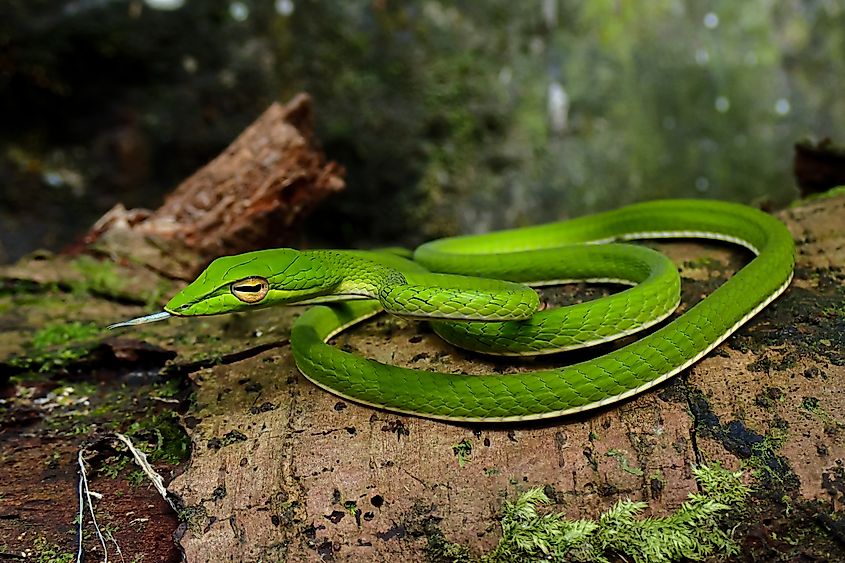
Capping off our green-themed serpent list is the Asian vine snake (Ahaetulla prasina), also known as the Oriental whip snake, Jade wine snake, Boie's whip snake, and/or Gunther's whip snake. Like many of its bright-green brethren, this snake is exceptionally slim—being only about the width of a finger at its bulkiest, before tapering down to a pencil-width neck and up to 6 feet long. Its distinctive head then increases slightly in width, before once again tapering, rather dramatically, into a pronounced snout (thereby resembling a spearhead).
The Asian vine snake can be found throughout the southern reaches of its namesake continent—from India through to southern China and Indonesia—in forests, gardens, and anywhere else that allows them to blend in. Curiously, its fangs are grooved, rather than hollow, and it has to repeatedly chew in order to inject its reptile/amphibian-killing venom.
Parting Thoughts
These green, mean (sometimes), camouflage machines have all adapted to the foliage around them—be it tropical, nearartic, or urban environments. And though the nature-inspired coloration is something all of these snakes have in common, their size, appetites, and temperaments vary as much as the continents they roam. What other color categories do snakes slither into? Perhaps in future articles we can continue to awaken the artistic herpetologist within.











